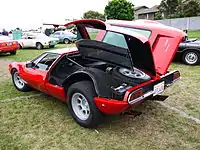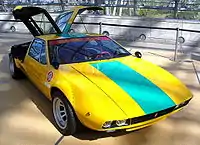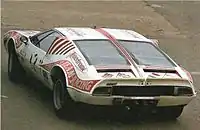De Tomaso Mangusta
The De Tomaso Mangusta is a sports car produced by Italian automobile manufacturer De Tomaso between 1967 and 1971. It was succeeded by the De Tomaso Pantera.
| De Tomaso Mangusta | |
|---|---|
_jm20706.jpg.webp) | |
| Overview | |
| Manufacturer | De Tomaso |
| Production | 1967–1971 (401 produced) |
| Designer | Giorgetto Giugiaro at Ghia |
| Body and chassis | |
| Class | Sports car (S) |
| Body style | 2-door coupé |
| Layout | Rear mid-engine, rear-wheel-drive |
| Powertrain | |
| Engine |
|
| Transmission | ZF 5-speed manual |
| Dimensions | |
| Wheelbase | 2,500 mm (98.4 in)[1] |
| Length | 4,275 mm (168.3 in)[1] |
| Width | 1,834 mm (72.2 in)[1] |
| Height | 1,100 mm (43.3 in)[1] |
| Curb weight | 1,300 kg (2,866.0 lb)[2] |
| Chronology | |
| Predecessor | De Tomaso Vallelunga |
| Successor | De Tomaso Pantera |
History

The Mangusta replaced the Vallelunga model, on which its chassis was based.[3] The word "mangusta" is Italian for "mongoose", an animal that can kill cobras. It was rumored that the car was so named in retaliation to a failed deal between De Tomaso and Carroll Shelby.[4] Alejandro de Tomaso offered to help Carroll Shelby to build a new Can-Am race car at the end of 1964 when Shelby found that the Shelby Cobra would not be able to compete there. De Tomaso was planning to develop a new 7.0-litre V8 engine for racing so he saw this as a perfect opportunity. Shelby agreed to finance the project and also sent a SCCA approved design team headed by Pete Brock to Italy in order to handle the design work. De Tomaso had conflicts on the design of the car. He also failed to deliver the agreed 5 race cars within the deadline for the 1965 Can-Am season. This caused Shelby to eventually back out of the project and join the development team of the Ford GT40. Peter Brock and his team were able to finish the car according to their will. De Tomaso engaged Carrozzeria Ghia to finalise the design of the car which was being developed under the project name of P70. The single completed car was displayed at the 1965 Turin Motor Show as the Ghia De Tomaso Sport 5000. De Tomaso then modified the steel backbone chassis of the P70 and it became the basis for the Mangusta, which was designed by Giorgetto Giugiaro at Ghia. The Mangusta entered production in 1967, at the same time De Tomaso had purchased Ghia.[5][6]
401 cars in total were built, about 150 were made for Europe, while the remainder were made for North America. The initial cars are claimed to have a more powerful Ford HiPo 289 engine; the later cars all had Ford 302 engines. The Mangusta was imported into the United States via a federal waiver which applied to the car due to its small production numbers. The waiver exempted the car from safety regulations which were in effect in the time as the Mangusta came without seat belts and had headlights far lower than what the federal regulations allowed. When this exemption expired, the front of the car was redesigned in order to accommodate two pop-up headlamps instead of the quad round headlamps present earlier. These new headlamps functioned through a crude lever-and-cable arrangement, which fed into the cabin.[7] An estimated 50 cars were produced in this configuration. One car was built with a Chevrolet engine for General Motors-Vice President, Bill Mitchell.[8]
Specifications
The Mangusta was designed by Giorgetto Giugiaro, whose main highlight is a center-hinged, two-section hood that opened akin to gullwing doors. The European version was fitted with a mid-mounted 306 hp (228 kW) Ford 289 V8 engine, driven through a 5-speed ZF transaxle; in North America a 230 hp (170 kW) Ford 302 V8 was used. The Ford 289 engine was later replaced by the Ford 302 engine in the European version as well. All round disc brakes and independent suspension, rack and pinion steering, air conditioning, and power windows were fitted, ahead of other manufacturers at the time. Journalist Paul Frère claimed he achieved a top speed of 250 km/h (155 mph) in the Mangusta.[3]
The Mangusta was relatively inexpensive for the time, but with a 44/56[9] front/rear weight distribution and a less than solid chassis suffered from stability problems and poor handling. The car's cabin was also cramped and it had extremely low ground clearance.[3]
Revival
The Mangusta name was revived in the early 2000s when the concept car De Tomaso Biguà became the Qvale Mangusta, after a dispute between De Tomaso and business partner Qvale. The Qvale sold only in limited numbers.
Media
In the 2004 movie Kill Bill: Volume 2, the character Bill (David Carradine) has a silver Mangusta. In the music video to the Kylie Minogue song "Can't Get You Out of My Head", a yellow Mangusta can be seen. A red Mangusta is seen and mentioned in conversation in the 1971 Disney movie The Barefoot Executive. The 1974 movie Gone in 60 Seconds featured a white Mangusta.[10]
Gallery
 The De Tomaso Mangusta featured unique gull wing doors covering both the engine and luggage compartment
The De Tomaso Mangusta featured unique gull wing doors covering both the engine and luggage compartment De Tomaso Mangusta Group 4 GT
De Tomaso Mangusta Group 4 GT Mangusta in racing livery
Mangusta in racing livery
References
- "1967 De Tomaso Mangusta Technical specifications". carfolio.com. Retrieved 2013-09-30.
- https://detomaso-automobili.com/mangusta/#section-specifications
- Lawrence, Mike (1997). A to Z of Sports Cars 1945-1990. Bay View Books Ltd. ISBN 1-870979-81-8
- Ben Branch, "The Shelby De Tomaso P70",Silodrome, 12 August 2019
- Pètràny, Màtè (4 July 2019). "De Tomaso Is Back With a Gorgeous New Stick-Shift Supercar". Road & Track. Retrieved 5 July 2019.
- Bruce, Chris (26 February 2018). "Low-Mileage 1969 De Tomaso Mangusta Demands $300,000". Motor1. Retrieved 5 July 2019.
- Kaslikowski, Adam (20 February 2013). "The De Tomaso Mangusta, An Alternative Vision". Petrolicious. Retrieved 5 July 2019.
- "De Tomaso Mangusta Speciale « QV500". Web.archive.org. 2011-07-05. Archived from the original on July 5, 2011. Retrieved 2012-04-14.
- Mangusta (De Tomaso) specifications https://mundomotorweb.files.wordpress.com/2013/11/de-tomaso-mangusta.pdf
- "De Tomaso Mangusta in IMCDB". Imcdb.org. Retrieved 2019-07-07.
External links
| Wikimedia Commons has media related to De Tomaso Mangusta. |
- Pictures of a 1969 De Tomaso Mangusta
- The PROVAMO registry of De Tomaso Automobiles
- The Mangusta International Mangusta Registry
- The QV500 Registry of De Tomaso Automobiles
- A small De Tomaso registry in Excel format that can be downloaded. Includes a page dedicated to the Mangusta